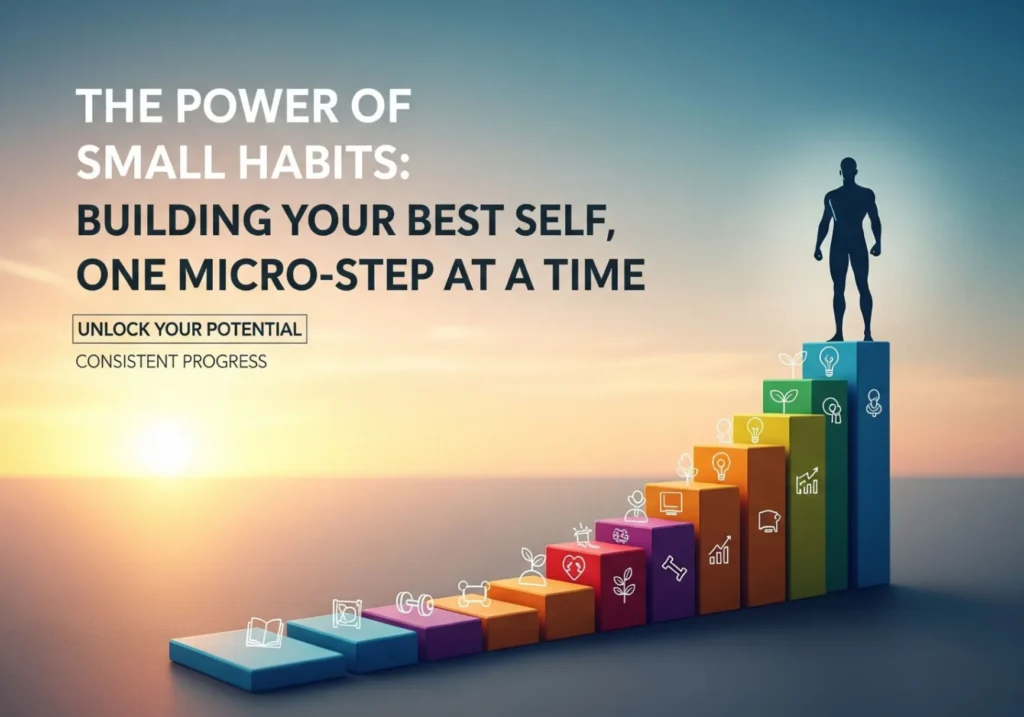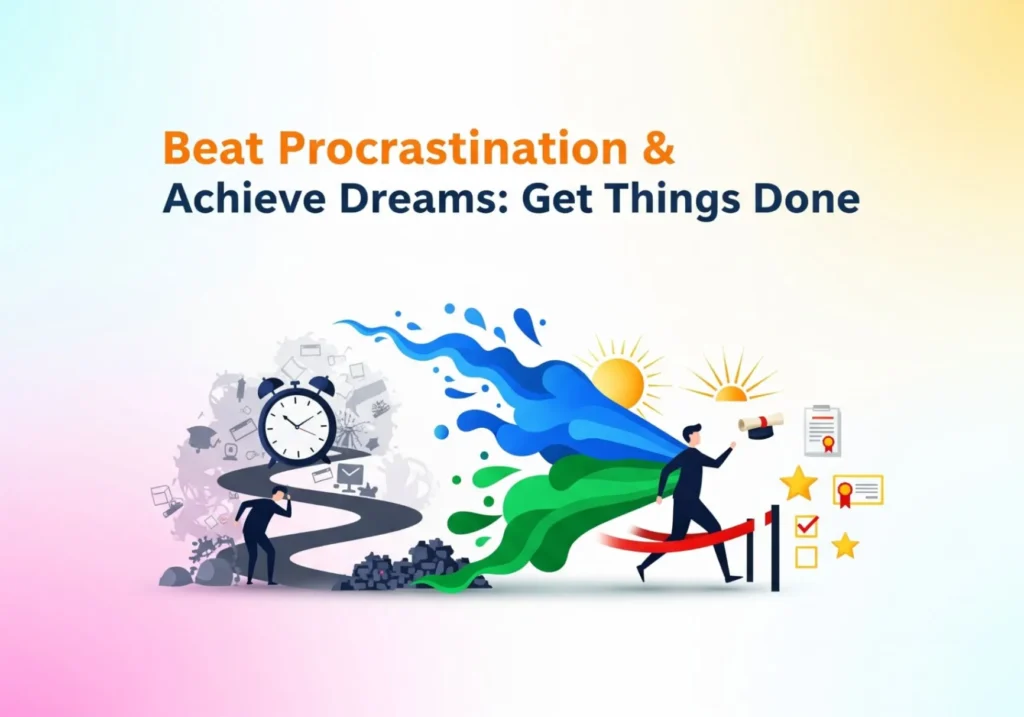The Power Hour: How to Achieve Your Wildest Goals in Just 60 Minutes a Day
Stop saying “I don’t have time.” Here’s the simple, compounding system to learn a new skill, get in shape, or build your dream project—one focused hour at a time.
It sounds too simple to be true, but the most profound transformations are built on the smallest, most consistent steps.
Table of Contents
The Grand Illusion of “No Time”
You’ve said it, haven’t you? “I’d love to learn Spanish.” “I wish I could finally get in shape.” “I’ve always wanted to write a novel.”
These aspirations almost always end with the same defeated sigh: “But I just don’t have the time.”
We live under the tyranny of the urgent. Our calendars are a battlefield of obligations, our inboxes are a relentless flood, and our days feel like a frantic sprint from one task to the next. The idea of adding another “thing” seems impossible. We dream of grand, sweeping changes, but the sheer scale of our ambition paralyzes us before we even begin.
But what if the secret to achieving those life-altering goals isn’t a complete life overhaul? What if it’s hidden in the small, seemingly insignificant pockets of your day? What if the key to unlocking your future self lies in just one, single, fiercely protected hour?
“The secret of getting ahead is getting started. The secret of getting started is breaking your complex overwhelming tasks into small manageable tasks, and starting on the first one.” – Mark Twain
This article is about that first, manageable task. It’s about the profound, compounding magic of the Power Hour—a concept so simple yet so potent that it has the capacity to fundamentally change the architecture of your life.
The Compounding Magic of 365 Hours
One hour a day doesn’t sound like much. It’s easy to dismiss. But consistency is a quiet superpower. Let’s do the math.
- 1 hour per day = 7 hours per week
- 7 hours per week = ~30 hours per month
- 30 hours per month = 365 hours per year
Pause and truly absorb that number. 365 hours is the equivalent of more than nine 40-hour work weeks. That’s over TWO full months of dedicated, focused work that you can gift yourself every single year.
What could you accomplish with two extra months of focused effort? Could you learn the fundamentals of a new programming language? Write the first draft of your book? Become significantly stronger and healthier? The answer is a resounding, undeniable yes.
This is the principle of compounding, famously applied to finance but equally true for personal development. Small, consistent investments of time yield disproportionately massive returns. The first few days, you’ll barely notice a difference. But after a month, you’ll feel momentum. After six months, you’ll see tangible results. After a year, you won’t recognize the person you were when you started.
How to Find and Protect Your Power Hour
The most common objection is, “I genuinely don’t have a spare hour.” While life is demanding, most of us leak time in ways we don’t realize. Finding your hour isn’t about magic; it’s about a conscious audit and intentional scheduling.
Step 1: Become a Time Detective
For one or two days, be brutally honest. Track where your time actually goes. Use a notebook or a simple app. You’ll likely be shocked. The 15 minutes scrolling Instagram between tasks, the 20 minutes down a YouTube rabbit hole, the half-hour of channel surfing before bed—it all adds up to a significant reservoir of reclaimable time.
Step 2: Identify and Plug the Leaks
Where is your time vanishing? The primary culprits are often passive entertainment and mindless scrolling. A 2023 report shows the average person spends nearly 2.5 hours a day on social media. You don’t need to eliminate these things, but could you consciously reclaim 60 minutes from them? Absolutely.
Step 3: Schedule It and Defend It
Once you’ve identified a slot, schedule your Power Hour as if it were a meeting with your CEO. Put it in your calendar with a notification. Tell your family about it. Treat it as sacred and non-negotiable.
- The Golden Hour (e.g., 5 AM – 6 AM): The world is quiet. No emails, no calls, no distractions. A pristine, creative space for many of the world’s most successful people.
- The Lunch Power-Up: Reclaim your lunch break. Use 20-30 minutes to eat and the rest for your focused task, returning to work re-energized.
- The Post-Work Transition: Use the hour immediately after work to shift gears from your job to your personal growth, before evening inertia and decision fatigue set in.
- The Last Stand (e.g., 10 PM – 11 PM): Once the house is quiet and the day’s obligations are met, this can be a peaceful, focused time for night owls.
The key is to find what works for your life and your energy levels, and then defend that time as if your future depends on it—because it does.
The 3 Golden Rules of a Successful Power Hour
To make this hour truly transformative, it needs structure. Follow these three rules:
- One Goal Only. This is not a multi-tasking hour. It is a deep-work monolith. Pick one project or skill and dedicate the entire hour to it. Writing your novel? Don’t also check emails. Learning to code? Close social media tabs. Focus is your currency.
- Zero Distractions. Put your phone in another room or turn on “Do Not Disturb.” Close unnecessary browser tabs. Use noise-canceling headphones if you have to. Create a bubble of pure, uninterrupted concentration.
- Perfection is the Enemy. The goal of the Power Hour is not a perfect outcome every single time. The goal is to show up. Some days you’ll be on fire; other days you’ll struggle. It doesn’t matter. Showing up and putting in the effort is the victory. Consistency beats intensity.
The Four Pillars of Transformation (With Real-World Examples)
So, you’ve found your hour and you know the rules. What do you do with it? The possibilities are endless, but they generally fall into four key areas of life improvement. Let’s explore them.
Pillar 1: The Hour of Mastery (Intellectual Growth)
This hour is dedicated to learning a new skill that can advance your career or enrich your life.
Example: Sarah, the Aspiring Coder
Sarah, a marketer, sees that data analysis is crucial for senior roles in her field. She dedicates 6 AM to 7 AM every weekday to learning Python.
- Months 1-3: She uses free resources like FreeCodeCamp. It’s slow and frustrating, but she masters the basics: syntax, data types, and loops.
- Months 4-6: Things start to click. She uses a course on Udemy to build small projects. She automates a repetitive weekly reporting task at her job, impressing her boss.
- Months 7-12: The Transformation. Sarah is now confident enough to tackle larger datasets. Her portfolio of projects helps her pitch a new customer analytics dashboard. She earns a promotion and a significant raise, moving into a data-driven role she once thought was out of reach.
More “Hour of Mastery” Ideas: Learning a language with Duolingo and a textbook, studying for a professional certification, reading one non-fiction book per week, or taking a course on graphic design.
Pillar 2: The Hour of Well-being (Physical & Mental Health)
This hour is a non-negotiable investment in your most important asset: your body and mind.
Example: Mark, the Overwhelmed Office Worker
Mark is 45, overweight, and constantly stressed. His doctor warns him about high blood pressure. He reclaims his lunch break for an “Hour of Well-being.”
- Months 1-3: He starts small: a 45-minute brisk walk and a 15-minute guided meditation using an app like Calm or Headspace. He starts losing weight and feels less tense in the afternoons.
- Months 4-6: His fitness improves. Walks become light jogs. His energy and clarity skyrocket. His sleep improves dramatically.
- Months 7-12: The Transformation. Mark has lost 30 pounds, and his blood pressure is normal. He completed a 5K race, something he never thought possible. His daily hour has become the anchor of his day, transforming not just his health, but his entire outlook.
More “Hour of Well-being” Ideas: A home workout routine (HIIT, yoga, weightlifting), daily journaling and reflection, or spending an hour preparing healthy meals for the week.
Pillar 3: The Hour of Creation (Passion Projects & Side Hustles)
This hour is for building something of your own, whether it’s a creative work, a side business, or a personal project.
Example: Emily, the Dormant Artist
Emily loved painting but hasn’t touched a brush since college. Craving a creative outlet, she dedicates 9 PM to 10 PM to her art.
- Months 1-3: Her skills are rusty, but she commits to the daily practice, sharing her progress on a new Instagram account.
- Months 4-6: She develops a consistent style. Her confidence grows. People start asking if she sells her work. Encouraged, she opens an Etsy shop and makes her first sale—a moment of pure joy.
- Months 7-12: The Transformation. Her Instagram has a modest but engaged following. Her Etsy shop brings in a few hundred dollars a month—not a living, but a powerful validation. More importantly, she has reconnected with a part of herself she thought was lost. The income is a bonus; the fulfillment is the real prize.
More “Hour of Creation” Ideas: Writing 500 words of a novel, developing a blog or YouTube channel, learning woodworking, or building an app.
Pillar 4: The Hour of Connection (Nurturing Relationships)
In our hyper-connected but often lonely world, this hour is about deep, meaningful, and undistracted human connection.
Example: David, the Distant Father
David, a busy executive, realizes his interactions with his kids are purely logistical. He implements a device-free “Connection Hour” from 7 PM to 8 PM every night.
- The Rule: For this one hour, all devices—his phone, the TV, tablets—are put away in a drawer. The hour is 100% dedicated to his children.
- The Impact: At first, it’s awkward. Soon, it becomes the most cherished part of the day. They build LEGO castles, read books aloud, and play board games. David learns about his kids’ friends, fears, and dreams. He’s no longer just a provider; he’s a present father. The quality of his family relationships transforms, creating a foundation of trust that no career success could ever replace.
More “Hour of Connection” Ideas: A dedicated, device-free hour with your partner, a weekly scheduled video call with parents or long-distance friends, or volunteering for a cause you care about.
Your Life is a Collection of Hours. Start with One.
The journey of a thousand miles begins with a single step. The transformation of a lifetime begins with a single hour. Don’t wait for the “perfect time.” It will never come. The perfect time is now.
Your Action Plan: How to Start Today
Feeling inspired? Good. Now, let’s turn that inspiration into action. Here’s a simple plan:
- Choose Your Pillar: Which of the four areas—Mastery, Well-being, Creation, or Connection—calls to you the most right now? You can only pick one to start.
- Define Your Goal: Be specific. Not “get fit,” but “do a 30-minute home workout and a 15-minute walk.” Not “write a book,” but “write 300 words.”
- Find and Schedule Your Hour: Look at your calendar for tomorrow. Block out 60 minutes. Set a reminder. Tell someone to hold you accountable.
- Prepare Your Environment: If you’re going to work out, lay out your clothes. If you’re going to write, clear your desk. Remove all friction.
- Just Begin: Tomorrow, when that alarm goes off, honor your commitment. It doesn’t have to be perfect. You just have to show up.
That’s it. The secret is that simple. The challenge isn’t the task itself; it’s building the discipline of consistency. But once that habit is forged, it becomes an unstoppable force for positive change in your life.
Your future self—the one who is healthier, wiser, more skilled, and more connected—is not wishing for more time. They are thanking you for starting with just one hour.
The question is no longer “Do you have the time?” The question is, “What will you do with your Power Hour?”










